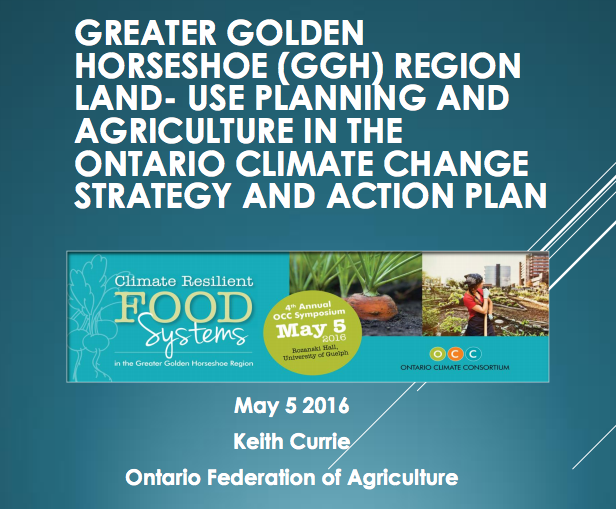 The 2016 Ontario Climate Symposium held earlier this month in Guelph stimulated a focused discussion on the future of food in the Greater Golden Horseshoe as it relates to climate change. A wealth of knowledgeable speakers were a part of the day’s learning, with attendees splitting off into workstreams in the afternoon.
The 2016 Ontario Climate Symposium held earlier this month in Guelph stimulated a focused discussion on the future of food in the Greater Golden Horseshoe as it relates to climate change. A wealth of knowledgeable speakers were a part of the day’s learning, with attendees splitting off into workstreams in the afternoon.
The Ontario Climate Consortium (OCC) have now shared these educational speaker presentations online available for download.
“From the presentations, to the student poster competition, to the formal and informal conversations that took place throughout the day, the Symposium exceeded all of our expectations,” the OCC has shared on their website.
The morning keynote was given by Evan Fraser, Canada Research Chair in Global Food Security at the University of Guelph, launching the day off with the stimulating question: what will food systems look like in 2050? Food and water shortages as a result of climate change and growing populations, Fraser says, are likely to trigger mass migration and unrest.
So what can we do?
Events like these are meant to tackle these daunting questions, explore integrated solutions, and encourage cross-sectoral involvement; we patently know that the agriculture sector is a major player here.
The morning Plenary Panel looked at the Role of Greater Golden Horseshoe (GGH) Region Land-Use Planning and Agriculture in the Ontario Climate Change Strategy and Action Plan.
Wayne Caldwell, Dean Ontario Agricultural College, Professor of Rural Planning and Development (University of Guelph), set the context for land use planning, agriculture and climate change, using some telling numbers to garner attention:
In 1973 the average value for an acre of farmland in Ontario was $440; the value of farmland in Ontario has since gone up nearly 2000%. Statistics Canada reported Ontario’s average value per farm acre at $8400 in 2013. And in Ontario, total farm area decreased by 8.7% between 1996 and 2011.
Caldwell encourages action ending with this: Every year the planet loses an area the size of Scotland to erosion and urban sprawl, and at the same time we add more than 80 million people to the population.
Clearly, adaptive solutions are necessary.
Environmental Commissioner of Ontario Dianne Saxe’s presentation focused on some research priorities and steps toward building better soil health, explaining that a 4% annual growth rate of soil carbon could stop the increase in atmospheric CO2. Saxe discussed what a healthy soil food web means: Plant health, Soil conservation, Reduced inputs, Carbon sequestration, Better water quality, Reduced flooding, and Climate resilience.
In her presentation, Saxe also brought back some information to share from last year’s Paris Climate Conference.
Keith Currie, Vice President Ontario Federation of Agriculture (and a member of the Co-ordinated Land Use Planning Advisory Panel) went over the Co-ordinated Land Use Planning Review as it relates to climate change, protecting agricultural land, water and natural areas. “Adoption of recommendations in the Advisory Panel report are based on public consultation,” explains Currie, “and are poised to have a tremendous positive impact on climate change into the future.”
Presentations are also online for the 3 afternoon workstreams:
– Sustainable Energy in the Agri-Food Supply Chain
– Exploring Pathways towards Low Carbon and Climate Resilient Agriculture in the GGH Region
– Planning for Climate Resilient Local and Regional Food Supply Chains in the GGH Region
These presentations establish why climate change and GHG emissions matter to agriculture in the Golden Horseshoe, what it means for food and farming, and why collaborative research and solutions are needed. Demand for agricultural products will continue to grow, so there is increased pressure to evaluate sustainability of our agroecosystems.
As Caldwell reminded, these things do not happen in a vacuum.
Feel free to share these resources and presentations, and check back on the OCC website as they post additional media content and the Symposium Summary Report.
